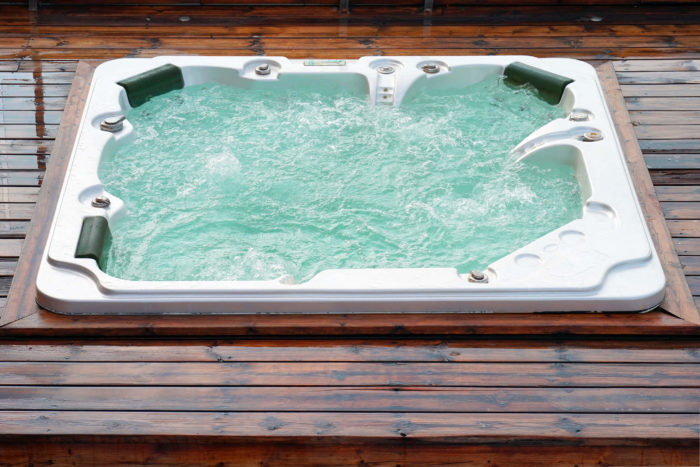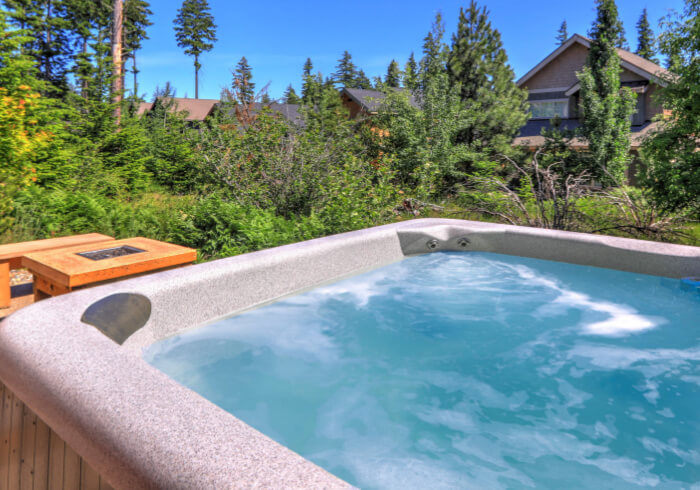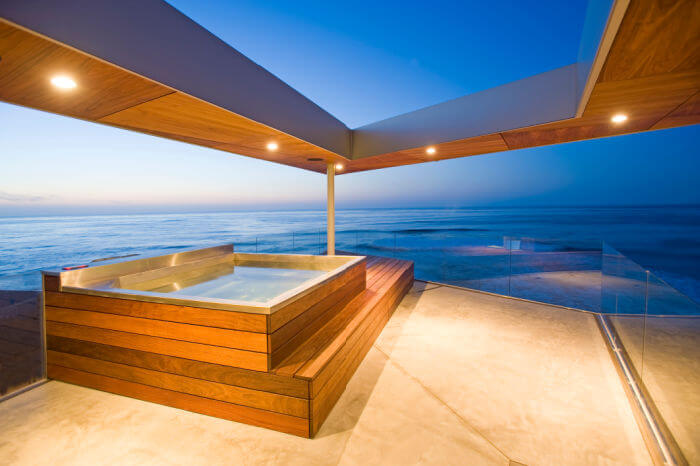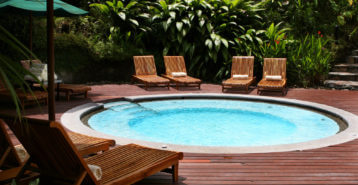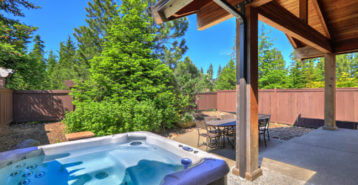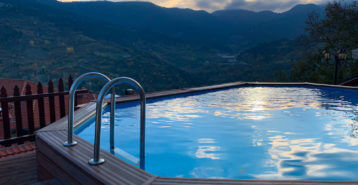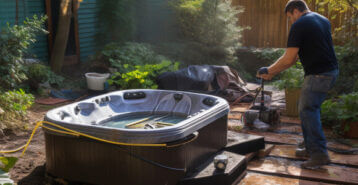How to Choose the Best Type of Hot Tub
There are many considerations that go into choosing your new hot tub. From the size and number of seats, to the number of jets, to the price – you will certainly be exploring many options during the research phase. A very important part of choosing the best type of hot tub that is often overlooked is the material.
When exploring your options, you want to be sure to look into materials for the hot tub shell (the interior) as well as the cabinet (the exterior). Ask questions such as: Why is one particular hot tub material better than another? Which material will be the longest lasting and give me the best return on my investment?
The hot tub material matters for a variety of reasons, not the least of which is energy efficiency, durability, and cost. On this page, we look at the best materials for hot tubs, both for the shells and the cabinets. We will talk about the pros and cons of each and the price points you can expect for each type of hot tub.
Understanding Hot Tub Parts
Before you dive into the rest of this guide, let’s talk about the different parts of the hot tub. This will make choosing hot tub materials easier. No matter how many bells and whistles a hot tub has, there are several common components you will find on every one of them. Here’s what those are:
- Cabinet. The large enclosure for the hot tub is called the cabinet. Essentially the cabinet is the exterior part of the hot tub, and is an important part of its structure and appearance. This can be made of a variety of materials, including wood, engineered wood, stone, synthetic stone, or brick.
- Shell. The shell, also known as the hot tub liner, is the interior of the hot tub that holds the water. The shell is an important part of how long your hot tub will last without damage, and how comfortable it is to sit in. It is often molded to specific requests, such as how many seats and the recline angle of those seats. It might be made of acrylic, plastic, or vinyl.
- Insulation. The layer between the cabinet and the shell is the insulation that helps keep the water in your hot tub as hot and comfortable as you like. High quality insulation has everything to do with energy efficiency – and how much you’ll be paying for energy to run the hot tub regularly!
- Jets. The tiny jets of the hot tub are where the magic happens. All that bubbling water is thanks to the air or water coursing through the jets by the action of the pump (which we will explain in detail below).
- Seats. The seats of your hot tub are part of the shell, as they are almost always molded to certain specifications. These seats can be quite simple in more basic models. They can also have a lower recline angle for lying down in the water or extra jets for added massage.
- Heater and pump. The heater and pump for your hot tub are located in the area underneath the shell that is enclosed by the cabinet. This is where all the electronics reside. They can be accessed by the door (or doors) in the cabinet.
- Accessories. The controls for the little extras, such as LED lights, can be found under the cabinet as well. These items will often be embedded or attached to the surface of the shell or cabinet, where they can display their ambiance.
Best Materials for Hot Tub Shells
When choosing a hot tub shell, there are a variety of options. Some of the most common shells include those made of acrylic, vinyl, and rotomolded plastic. When considering materials for hot tub shells, make sure to look into each material’s durability and lifespan, as well as energy efficiency.
Acrylic Hot Tub Shells
Hot tubs made with an acrylic shell are quite durable and heavy, speaking to the longevity of the material. These shells are made by melting a solid sheet of acrylic over a customized mold. This creates the smooth, curving lines of the seats and other features of the tub.
There are two types of acrylic shells: backed and unbacked. The backed shell has a layer of ABS polymer bonded to the underside. The unbacked shell often has a layer of fiberglass underneath it. Backed acrylic is often more desirable, especially for deeper tubs.
Acrylic shells can cost a bit more than the other options. However, they are known to be very durable, lasting many years without showing many signs of use. They also offer excellent temperature retention, which cuts down on energy costs.
Acrylic hot tubs are heavy enough that it is not easy to move them around, so they work well for a permanent addition to your home, such as an in-ground hot tub. Acrylic hot tubs can run between $8,000 and $12,000.
Rotomolded Plastic Hot Tub Shells
When it comes to durability, rotomolded plastic hot tub spas offer an impressive lifespan, mostly because of how they are made.
A plastic powder is inserted into a mold, heated to the melting point, then rotated (thus the name) until it covers the mold in a smooth, even layer. This results in a highly durable shell with a matte finish. It is very lightweight, which means it can be moved around to wherever you might please, and why it works very well for above-ground and portable spas.
These models might often be “plug and play” and require only a simple household outlet. The downside of that is that you might have trouble running the jets and heater at the same time.
Vinyl Hot Tub Shells
Vinyl shells are common among portable, inflatable, or soft-sided hot tubs. Given this, they are quite inexpensive when compared to plastic or acrylic.
They also do not offer the same longevity, are prone to discoloration in the sun, and can present tears or rips over time. However, those can often be repaired.
A vinyl shell is very lightweight and so can be moved to wherever you want it. When it comes to heat retention, they offer the lowest in energy-efficiency, so they are not a long-term solution for hot tub lovers. However, as an entry-level option, they work well for those who are deciding whether they want to go all-in on a nicer hot tub for their backyard.
Wood Hot Tub Shells
Once upon a time, wood shells for hot tubs were quite popular. Today, wood has been replaced by the above materials for the sake of durability. But when it comes to beauty, nothing matches the look of wood.
Some high-end hot tubs are still made with shells of cherry, redwood, cedar, and other coveted trees. Maintenance is a serious requirement for these shells, as they must be stained and sealed on a regular basis to ensure they stay watertight.
Wood hot tub shells cannot be molded into smooth shapes, so you’d be looking at a very classic hot tub design with some edges throughout. This might work well for homes with a modern aesthetic, or those who want a true throwback design. Expect to pay a hefty price for the initial purchase and the ongoing maintenance this shell will require.
Best Materials for Hot Tub Cabinets
Hot tub cabinets are designed to be the “base” for above-ground tubs. They are the first part of the hot tub people will see, as they make up the exterior. However, while appearance matters when choosing the best type of hot tub, you also want to think about the cabinet’s energy efficiency.
For many years, all hot tub cabinets were made of wood. Though wood remains a very popular option, today there are others to consider – such as synthetic wood, stone or faux stone, and brick or faux brick. Note that you do not have to have the same material for your cabinet as your shell. For instance, choosing a wood hot tub cabinet does not mean you must go with a high-end wood shell, as the acrylic shell would be a great choice.
Below we outline the best types of materials for hot tub cabinets, including their durability, appearance, and upkeep needs.
Note: Prices for different types of hot tub can vary widely based on sizes, seats, and quality. We recommend looking at our hot tub cost guide for the most accurate pricing information.
Wood Hot Tub Cabinets
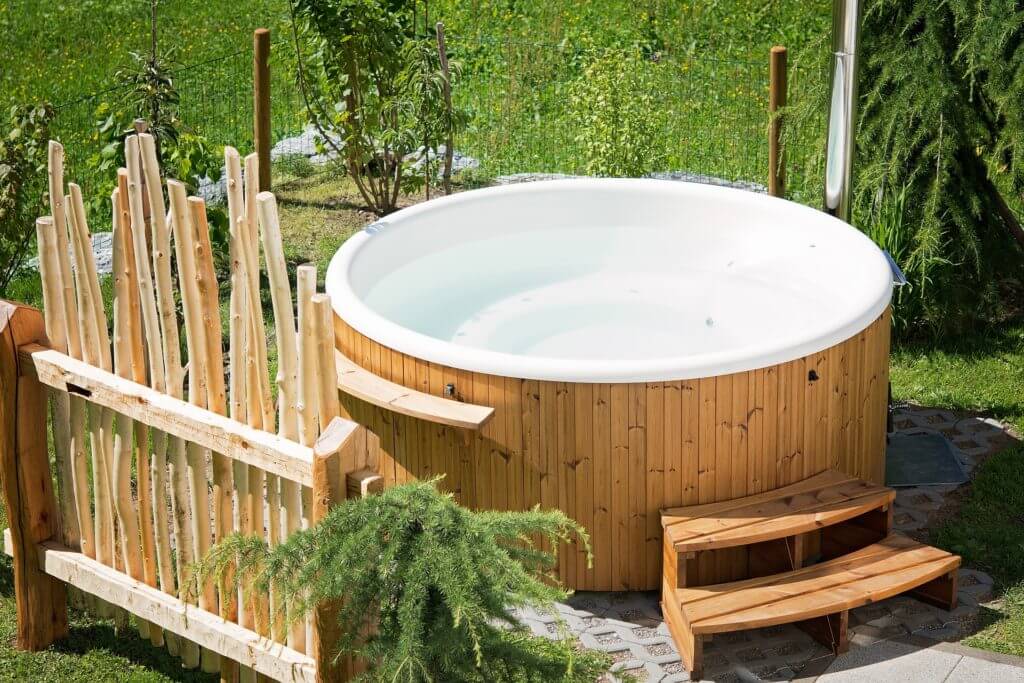
The classic material for hot tub cabinets, wood imparts visual warmth that other materials simply cannot match. But it does have limitations, particularly with the amount of maintenance required. Since a wood cabinet is in constant close proximity to water, it is vitally important to stain and seal the wood cabinet on a regular basis.
Redwood and cedar are the most common options for hot tub cabinets, and for a good reason. They are very resistant to insects, which gives you a cleaner tub with fewer worries about maintenance.
Though wood cabinets are more prone to rot from the presence of water, it is also possible to refinish a solid wood cabinet. This will allow it to bounce back from any damage and give you many more good years of service. You can expect a wood hot tub to cost between $3,000 to $10,000+, depending on the size.
Synthetic Wood Hot Tub Cabinets
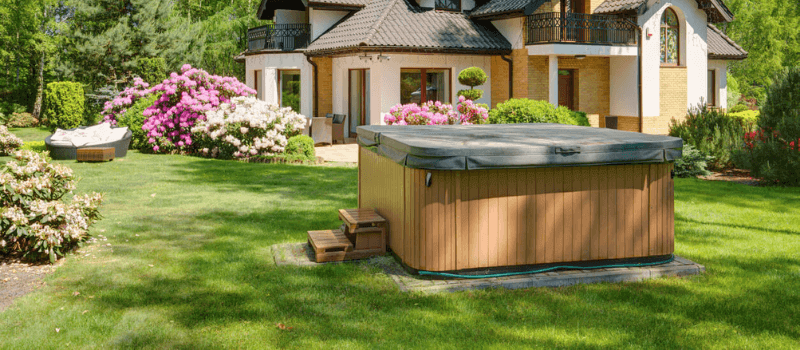
Synthetic wood hot tubs look just like wood. But they are actually made of plastic, fiber cement, or a similar material that stands up to the elements without the need for staining or sealing. This makes it a much longer-lasting material that requires very little maintenance.
A synthetic wood hot tub cabinet is also available in a wide variety of colors you might not be able to achieve with staining of solid wood. No matter what color you choose, most of them are highly resistant to UV rays and will not discolor in the sun. In most cases, synthetic wood is a bit cheaper than real wood.
Faux Stone Hot Tub Cabinets
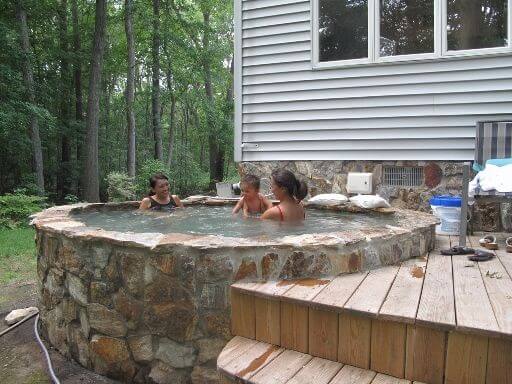
Just as with different types of real wood grain and the colorations of synthetic wood, the options for faux stone are endless colors and designs.
Faux stone hot tubs are best for modern homes and backyards, where the stone reflects the design of the larger deck or patio area. Though stone can be a bit pricier than wood or synthetic wood options, it also requires much less maintenance. This can make up for that higher price tag – $5,000 to $12,000+, depending on the size and type.
Brick or Faux Brick Hot Tub Cabinets
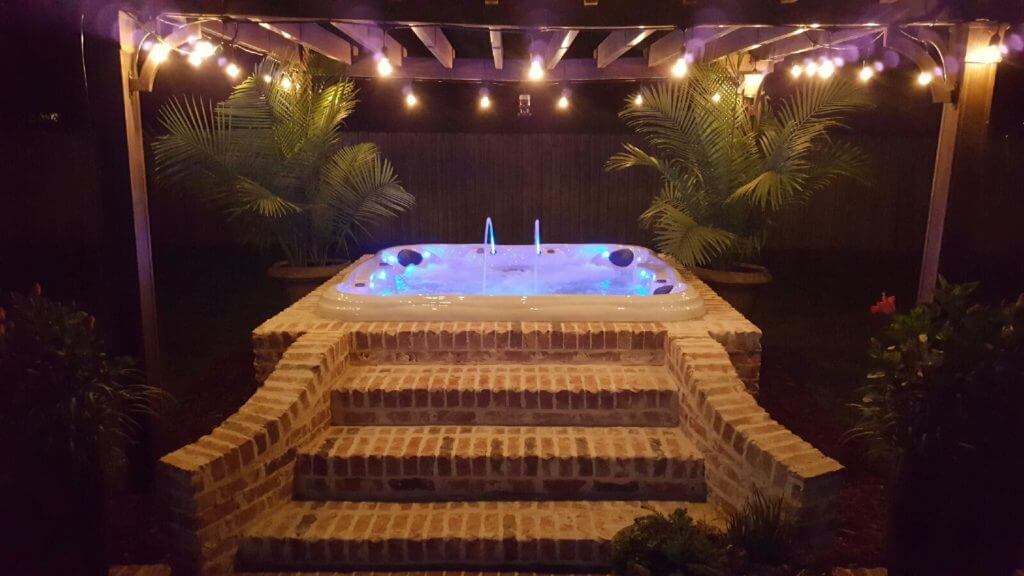
Brick is one of those unique hot tub materials that is just at home in a very modern setting as it is in a very traditional one.
When using real brick and mortar for a hot tub, keep in mind that it will need consistent maintenance. You will need to prevent the water from eventually seeping into the joints and the brick itself, which can lead to scaling and other issues. Faux brick can cut down on this issue. But remember that faux brick is often made of actual brick, just much smaller pieces of it.
Hot Tub Insulation and Energy Efficiency
When it comes to energy efficiency, what matters the most is the insulation that fills the space in the cabinet, not the material itself.
A standard hot tub uses 400 gallons of water. All that water needs to be heated for proper use. Over time, the electricity costs for heating that water can add up, so it pays to shave every little bit off the bottom line. High quality hot tub insulation can help keep the costs low. This way, you can enjoy the hot tub as often as you like without worry about what it’s doing to your utility bills.
The best way to insulate your hot tub is to go with a strong, sturdy, insulated cover. This helps prevent heat loss from the top of the tub.
But what about the cabinet itself? There are three common insulation options you will find on the market today: Full foam, partial foam, and thermal wraps.
Full foam insulation
Recommended for best energy-efficiency.
Insulation fills the entire space between the shell and the cabinet, leaving only small areas open for the electronics, pumps, and other requirements to run the hot tub. Not only does this provide excellent energy efficiency. It also helps support the pipes and other components of the tub, which can cut down on maintenance.
Partial foam insulation
More energy efficient than wood and inflatable hot tubs, but lower quality than full foam.
Insulation is placed over the hot tub inner shell. This is usually spray foam that contours to the shell. Rigid foam boards might also be used. The partial foam fills only part of the cabinet, so air can be lost, but not as quickly as it would be through a non-insulated hot tub shell or cabinet.
Thermal wrap
Lowest energy efficiency for hot tub insulation.
Thermal blanket insulation can be wrapped around the interior of the cabinet to reflect heat back toward the shell. It is often used in conjunction with spray foam insulation in a partial foam tub. Thermal wrap alone often is not sufficient to keep water hot enough for hot tub use.
Beginning the Installation
After learning about the best types of hot tubs, it is time to take a deeper dive into the different brands. Our page on the best hot tub brands can help you compare the models and options that might work best for your space. You can also look to backyard hot tub ideas for design inspiration.
Speaking of space, it is also important to measure properly for your hot tub, especially if you are making it a central design element or have limited space in your backyard or patio area.
Once you have a hot tub brand and size in mind, look into our budgeting tips to prepare for installation day.
As always, look to Modernize to help you find the right contractor to install your hot tub and handle the maintenance for years to come.
Compare top-rated hot tubs pros in your area.
Read real homeowner reviews, explore qualifications, and view promotions. Modernize makes it easy to browse professionals and find one that will be perfect for your project.

